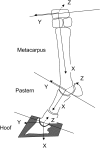In vivo measurements of flexor tendon and suspensory ligament forces during trotting using the thoroughbred forelimb model
- PMID: 24834009
- PMCID: PMC4019201
- DOI: 10.1294/jes.25.15
In vivo measurements of flexor tendon and suspensory ligament forces during trotting using the thoroughbred forelimb model
Abstract
The purpose of this study was to create a lower forelimb model of the Thoroughbred horse for measuring the force in the superficial and deep digital flexor tendons (SDFT and DDFT), and the suspensory ligament (SL) during a trot. The mass, centers of gravity, and inertial moments in the metacarpus, pastern, and hoof segments were measured in 4 Thoroughbred horses. The moment arms of the SDFT, DDFT, and SL in the metacarpophalangeal (fetlock) and distal interphalangeal (coffin) joints were measured in 7 Thoroughbred horses. The relationship between the fetlock joint angle and the force in the SL was assessed in 3 limbs of 2 Thoroughbred horses. The forces in the SDFT, DDFT, and SL during a trot were also measured in 7 Thoroughbred horses. The mass of the 3 segments, and the moment arms of the SDFT and DDFT in the fetlock joint of the Thoroughbred horses were smaller than those of the Warmblood horses, whereas the other values were almost the same in the 2 types. The calculated force in the SDFT with this Thoroughbred model reached a peak (4,615 N) at 39.3% of the stance phase, whereas that in the DDFT reached a peak (5,076 N) at 51.2% of the stance phase. The force in the SL reached a peak (11,957 N) at 49.4% of the stance phase. This lower forelimb model of the Thoroughbred can be applied to studying the effects of different shoe types and change of hoof angle for the flexor tendon and SL forces.
Keywords: Thoroughbred; inertial moment; inverse dynamics; segment center of gravity; tendon.
Figures
Similar articles
-
Influence of shoeing on ground reaction forces and tendon strains in the forelimbs of ponies.Equine Vet J. 1996 Mar;28(2):126-32. doi: 10.1111/j.2042-3306.1996.tb01604.x. Equine Vet J. 1996. PMID: 8706644
-
Load redistribution after desmotomy of the accessory ligament of the deep digital flexor tendon in adult horses.Vet Q. 1996;18 Suppl 2:S70-4. Vet Q. 1996. PMID: 8933678
-
Effect of uphill exercise on equine superficial digital flexor tendon forces at trot and canter.Equine Vet J Suppl. 2006 Aug;(36):435-9. doi: 10.1111/j.2042-3306.2006.tb05583.x. Equine Vet J Suppl. 2006. PMID: 17402462
-
Long-term consequences of experimental desmotomy of the accessory ligament of the deep digital flexor tendon in adult horses.Am J Vet Res. 1998 Mar;59(3):347-51. Am J Vet Res. 1998. PMID: 9522956
-
Muscle-tendon stresses and elastic energy storage during locomotion in the horse.Comp Biochem Physiol B Biochem Mol Biol. 1998 May;120(1):73-87. doi: 10.1016/s0305-0491(98)00024-8. Comp Biochem Physiol B Biochem Mol Biol. 1998. PMID: 9787779 Review.
Cited by
-
A review of the equine suspensory ligament: Injury prone yet understudied.Equine Vet J. 2025 Sep;57(5):1167-1182. doi: 10.1111/evj.14447. Epub 2024 Nov 27. Equine Vet J. 2025. PMID: 39604165 Free PMC article. Review.
References
-
- Abramoff M.D., Magelhaes P.J., Ram S.J.2004. Image processing with ImageJ. Biophotonics Int. 11: 36–42
-
- Buchner H.H., Savelberg H.H., Schamhardt H.C., Barneveld A.1997. Inertial properties of Dutch Warmblood horses. J. Biomech. 30: 653–658 - PubMed
-
- Butcher M.T., Hermanson J.W., Ducharme N.G., Mitchell L.M., Soderholm L.V., Bertram J.E.2007. Superficial digital flexor tendon lesions in racehorses as a sequela to muscle fatigue: a preliminary study. Equine Vet. J. 39: 540–545 - PubMed
-
- Clayton H.M., Schamhardt H.C., Willemen M.A., Lanovaz J.L., Colborne G.R.2000. Kinematics and ground reaction forces in horses with superficial digital flexor tendinitis. Am. J. Vet. Res. 61: 191–196 - PubMed
-
- Crevier-Denoix N., Pourcelot P., Ravary B., Robin D., Falala S., Uzel S., Grison A.C., Valette J.P., Denoix J.M., Chateau H.2009. Influence of track surface on the equine superficial digital flexor tendon loading in two horses at high speed trot. Equine Vet. J. 41: 257–261 - PubMed
LinkOut - more resources
Full Text Sources
Other Literature Sources


